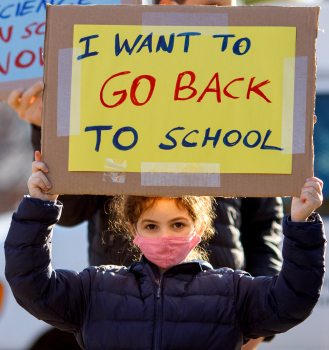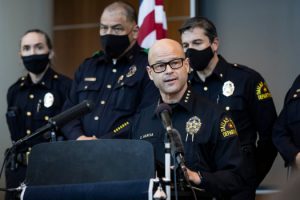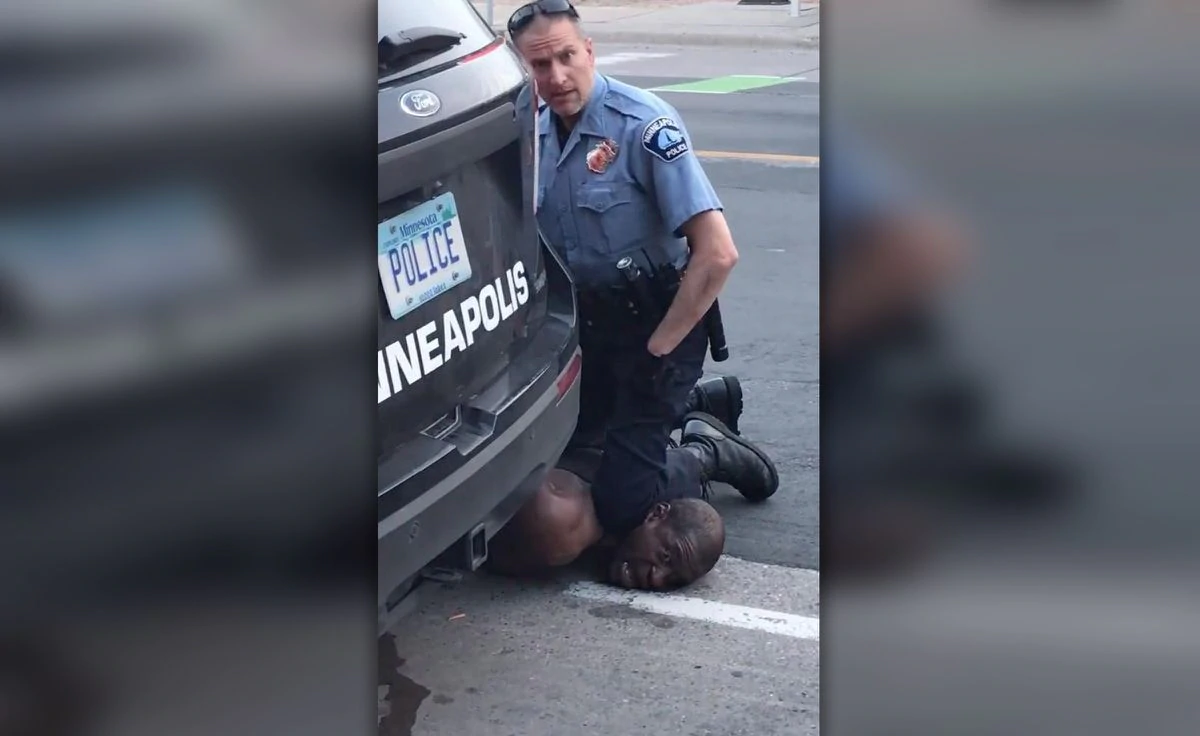ALBANY, CA – FEBRUARY 10: Alma Bar-Tura, 7, a first grader, protests with her family along Solano Avenue near the Albany Unified School District Student Enrollment Center in Albany, Calif., on Wednesday, February, 10, 2021. Parents and students held the demonstration to call for the reopening of schools. (Anda Chu/Bay Area News Group)
The $6.6 billion compromise bill loaded with incentives to entice more schools to reopen this spring was headed to Gov. Gavin Newsom’s desk Thursday after passing out of the legislature with bipartisan support — and acknowledgment of its shortcomings.
The legislation, Assembly and Senate bills 86, offers public schools a share of $2 billion in aid for reopening costs if they resume some level of in-person instruction by the end of March, with decreasing amounts up to a May 15 deadline. An additional $4.6 billion is aimed at helping address learning loss from remote instruction. The Assembly passed the bill 72-4 after the Senate approved it 36-0.
“Like everybody said, this bill may not be what’s best for you, your family or your district, but I believe this bill is the best for our state,” said Assemblyman Phil Ting, D-San Francisco, who led the effort to craft a bill to help speed reopening of public schools, in which California has lagged other states.
Gov. Gavin Newsom said earlier in the week he expects to sign the bill, a compromise his administration helped draft after his December plan and earlier legislative efforts stalled.
The bill has drawn sharp criticism from parents who wanted state leaders to compel schools to bring back students over objections from teacher unions. The unions have have argued it’s unsafe to return to classrooms until teachers and staff are fully vaccinated against the coronavirus, or until infection rates drop.
Raj Singh, among dozens of Cupertino parents planning a school reopening rally Friday, said many districts have indicated the bill won’t change their reopening timeline, and that most of the money it makes available isn’t tied to reopening deadlines. It allows partial reopening for just a few hours a week, or even guarantee a return full time in the fall. Teacher unions, he said, have too much sway over school boards and lawmakers.
“It’s become a rigged system and the kids are losing,” lamented Singh, noting the closures have driven many parents to private schools that for the most part have been open.
Health officials have said for months that studies of schools around the country that have been teaching in-person have demonstrated it’s safe to resume classroom instruction before teachers are vaccinated, even amid high infection rates, with measures like face masks and physical distancing to reduce risk.
Those studies and others showing that show students — particularly the poorest and most vulnerable — are falling behind and suffering emotionally since online “distance learning” substituted for live instruction nearly a year ago have intensified the reopening debate.
Ting, whose daughters attend San Francisco schools that remain in distance learning, noted that lawmakers were motivated to act by seeing the affect of closed schools on their own children.
In remarks on the Assembly floor, several Republican lawmakers blamed the ongoing school closures on Newsom, the target of a recall drive that has gained steam with frustrated parents.
“California gets an ‘F’ in how it dealt with education, period,” said Assemblyman James Gallagher, R-Chico, who talked about the impact of social isolation on his daughter as she entered high school via online classes and voted against the bill. “California deemed education non-essential. We kept many industries going. We deemed those businesses essential and we deemed schools and other businesses non essential and it’s a travesty that happened on our watch. I think the lion’s share of the blame lies with this governor.”
Assemblyman Kevin Kiley, R-Granite Bay, also blamed the Democrats for rejecting a proposed amendment he said would reopen schools sooner, accusing both of catering to the whims of teacher unions.
“This legislature is complicit in surrendering to the same special interest as the governor,” said Kiley, who likened it to seeing a kid drowning in a swimming pool and walking away. He also joined Gallagher and Assemblymen Vince Fong, R-Bakersfield, and Frank Bigelow, R-Placerville, in voting against the bill.
But other Republicans were supportive.
Laurie Davies, R-San Juan Capistrano, said she would give the bill a “C-minus” grade, but supported it because she said it provides funding for schools to increase staffing. Devon Mathis, R-Visalia, said he was satisfied with amendments that removed language critics feared could have forced new rounds of negotiations with teachers and stalled reopening.
“This without a doubt is one of the biggest bills we’ll be voting on this year,” Mathis said. “I did not come to my support lightly… It’s extremely frustrating to me we’re having to vote to reopen our schools when we all are aware of our governor’s ability to solve it with a pen stroke.”
Several Democrats defended the bill and the state’s handling of schools during the pandemic.
“Listen, this is a good bill, it gets schools reopened and helps address learning loss,” said Assemblyman Patrick O’Donnell, D-Long Beach, who chairs the education committee and noted he’s both a parent and former teacher. “Anyone who says teachers should enter classrooms without being vaccinated is full of malarkey.”
Others noted they represent many districts that have seen far higher infection rates than the suburbs and where parents, too, remain leery of sending their kids back to classrooms.
“As a former teacher, we know that’s where teachers need to be, but we’re afraid,” said Assemblywoman Cristina Garcia, D-Downey. “So are the families. They are afraid to send their kids to school.”
But she also acknowledged that her district has “some of the biggest learning loss, and I just have no clue how we’re going to catch up. I’m going to vote aye on this bill because I feel it’s important first step.”
The bill passed as the governor and his top health official detailed upcoming changes in the state’s color-coded, four-tier reopening blueprint that will allow more businesses and schools to reopen sooner, raising the infection rate for the boundary between most restrictive “purple tier” and second-most restrictive “red tier.”
“Schools are part of the blueprint,” Health and Human Services Secretary Dr. Mark Ghaly said. “So those counties anticipated opening in the red will now have a new threshold to meet to move forward with opening plans.”
That didn’t sit well with Assemblywoman Lorena Gonzalez, D-San Diego.
“There were negotiations being made based on tiers that are being changed now — it’s just not fair,” Gonzalez said. “You don’t negotiate a deal and then change the parameters of the deal on the day we’re voting on it. It’s dishonest, honestly.”



















